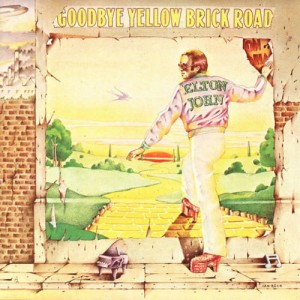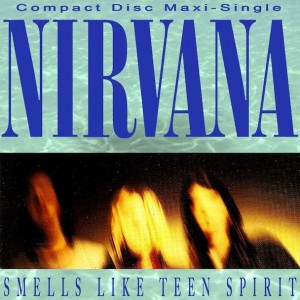Smarter in Sixty Seconds: Make Your (Musical) Mission Statement!
It’s that once in a lifetime crossroads of being a kid and starting to grow up. Ahh…to be 13 again.
Never again will you care about anything so passionately as you did when you were 13. Your heroes are very real and bigger than life and you would fight to the death to defend them.
A child of the Sixties, I became totally obsessed with rock and roll early on so my childhood heroes were mostly rock stars, which is why 1975 was a pretty awesome year to turn 13.
Here’s just a brief sampler of what came out that year:
Led Zeppelin / Physical Graffiti. David Bowie / Young Americans. John Lennon / Rock and Roll. Pink Floyd / Wish You Were Here. Jeff Beck / Blow By Blow. Aerosmith / Toys In The Attic. ZZ Top / Fandango. Elton John / Captain Fantastic and the Brown Dirt Cowboy. Queen / Night At The Opera. Earth, Wind & Fire / That’s The Way of The World. Frank Zappa / One Size Fits All. Alice Cooper / Welcome To My Nightmare, Average White Band / Cut The Cake. Rufus featuring Chaka Khan / Rufus. (And that’s just the stuff I was into.)
It’s simply mind-boggling how many seminal recordings were released in 1975. Music that still graces the airwaves today and continues to inspire and influence musicians more than three decades later. Could you even name that many songs released this past year, let alone whole albums, that you could confidently say we’ll be listening to 30 years from now? Could you name even one?
Putting a Price on Talent
It was a time when music was still held sacred. Musicians and composers of all genres could devote their lives to mastering the craft of making music because you could actually make a real career of it (if you had the goods to make the grade).
In the pre-internet era there was no technology that allowed anyone and everyone to express themselves freely to the world, no matter how much or little they sucked. You actually had to have real talent if you wanted a shot in hell at that career. And the competition was fierce but the rewards were great.
You could be a studio cat and find yourself playing on a record with John Lennon or Paul Simon or Ray Charles or Barbara Streisand. Or you could be a professional sideman and make some nice bread going on tour with them. You could get a gig in the symphony. You could work your way up in a recording studio and become an engineer or producer. Or you could write your own songs, develop your act and get a major label deal. Record hit songs. Blow up on the radio. Tour the world.
Back then we called them artists. Their music shaped our lives.
They toiled away on their masterworks somewhere far off in a distant land where magical things happened. In secret hideaways called recording studios. There was a mystique surrounding their work. Even their personal lives were shrouded in mystery, tabloid rumors and folklore. Everything was left to the imagination. And then one day they would emerge from the ether and unleash their new creation on the world and your life changed again.
Hello Yellow Brick Road
That’s how I’ll always remember Elton John. He was already a bona fide superstar after his previous smash hit album, Goodbye Yellow Brick Road took over the world along with his over-the-top stage persona at his live shows. The memory goes something like this:
I’m 13, standing alone shooting pool in an elaborate basement gameroom in a beautiful Fairfield County house while the beautiful people make out on a big beautiful couch. I’m not one of them, but I’m on the outer fringe of the inner circle so I get invited to their parties.
“Someone Saved My Life Tonight” from Elton’s newly released Captain Fantastic album is forever playing on a killer stereo system along with Goodbye Yellow Brick Road.
This was the eternal soundtrack to my life back then.
In the absence of cell phones, social networking, video games or a gazillion other myriad distractions we have today, all you had was your favorite music and the heroes who made it to see you through those tumultuous years. It was just me and Elton at those parties. His music floated through the air. I was down here on the ground.
Maybe that’s why we worshipped those artists like gods and goddesses. We could never see them or touch them. Their music reached deep down to our innermost selves and spoke to us like they could read our every thought. We became devoted followers. When you’re 13, it’s easy to see a world filled with heroes and villains. You still believe in magic.
The Brand Finale
But somewhere in there the magic stopped.
We stopped calling them artists and started talking about their brand. Suddenly, just focusing on the artform of making music wasn’t enough anymore. Now you had to think about your mission statement. Your marketing approach. Who was your target audience? How big is your Twitter following? What’s your Klout score? How were you going to uniquely position your brand? You know, like a product.
And if you were lucky enough to gain some traction with your music and build a major following you want to polish that brand. Expand into new markets. Find strategic partnerships to strengthen the brand. But in the new global economy how are you going to become a globally recognized brand if you don’t eventually think about branching out beyond that narrow musical platform? So you diversify.
What does a major artist brand look like today?
Pull up Google and type in Diddy or Ludacris or Jay-Z. Notice that the second thing to come up right after their Wiki profile is their NET WORTH. Click on any of the articles and you’ll learn all about their Forbes ranking along with all their various business enterprises and strategic alliances.
What’s the message here?
You can learn about Ludacris’ savvy early investment into Vitamin Water, which sent his net worth skyrocketing. Or Jay-Z’s recent PR snafu over the holidays with that Barney’s clothing endorsement and the racial profiling and subsequent arrests of African Americans outside Barney’s. But hey, he’s still hanging up there with the richest rappers at the top of Forbes list even if his street cred is being called into question now.
And of course, you have to mention Dr. Dre and Jimmy Iovine’s massive success with their Beats headphones. To their credit, at least they’ve drawn attention to our very real need to hear music in the way the artist intended for you to hear it.
All of them have become captains of industry. True global brands.
That’s the model. Make a few hits. Create strategic alliances and immediately diversify into other more lucrative endeavors like a clothing line or beauty products or movie deals. That’s how you go large.
Commercial Classics?
But does anyone really give a shit that Nicki Minaj has a new perfume out? Or Rihanna? Or Katy Perry?
Meanwhile, Chanel #5 will always be a classic. You’ll always put a smile on her face if you offer that one up on Valentine’s Day. Why? Because Chanel stood for elegance. High fashion. Period. There was no muddying the waters.
How quickly will Ciroc Vodka drop off the face of the earth once Diddy moves on to his next business venture and stops putting his mug on the ads? But we’ll still be drinking Stoli 100 years from now.
Some brands last. Most fade. Hey, even Kodak is gone.
Once you start blurring the lines between art and commerce it gets harder to decipher the original message. Or what that brand really stands for. Once we’re talking about your net worth, how much are we going to be talking about your music anymore?
Deep Purple Haze
Speaking of 1975, another seminal work came out that same year. It was the birth of Saturday Night Live. And of their many incredible groundbreaking performances, they once did a spoof on a TV commercial about a mystery floorwax with its own special warning about what happens when you blur the lines too much. It stars the original cast members and goes like this:
Cast:
Husband: Dan Akroyd
Wife: Gilda Radner
Spokesman: Chevy Chase
[ open on suburban kitchen, Wife and Husband arguing ]
Wife: New Shimmer is a floor wax!
Husband: No, new Shimmer is a dessert topping!
Wife: It’s a floor wax!
Husband: It’s a dessert topping!
Wife: It’s a floor wax, I’m telling you!
Husband: It’s a dessert topping, you cow!
Spokesman: [ enters quickly ] Hey, hey, hey, calm down, you two. New Shimmer is both a floor wax AND a dessert topping! Here, I’ll spray some on your mop…[ sprays Shimmer onto mop ]…and some on your butterscotch pudding. [ sprays Shimmer onto pudding ]
[ Husband eats while Wife mops ]
Husband: Mmmmm, tastes terrific!
Wife: And just look at that shine! But will it last?
Spokesman: Hey, outlasts every other leading floor wax, 2 to 1. It’s durable, and it’s scuff-resistant.
Husband: And it’s delicious!
Spokesman: Sure sis! Perks up anything from an ice cream sundae to a pumpkin pie! New Shimmer, for the greatest shine you ever tasted!
That’s what music feels like today.
The Real Deal
It’s music! No it’s a strategically marketed brand with a loyal consumer base that enthusiastically engages with the products and services they offer!
But the great artist lives on. Art is timeless.
Pull up Google again and type in Led Zeppelin or Pearl Jam or Neil Young or Nirvana or The Rolling Stones. You know what comes up? Album titles, discographies, tour information, song lyrics, etc. No mention about their net worth. Why not?
Because it pales in comparison to that new artist/brand/mogul money. Other than Sir Paul McCartney and Sir Elton John, most of those vintage rock stars are struggling to cobble together a meager couple hundred million at best.
Where’s that going to get you in a world of twenty year old dot com billionaires? That’s strictly old-rock-star-out-to-pasture-in-the-English-countryside chump change wealth in the new economy.
I know, I know. Those old crusty rock star aristocrats with their pompous attitudes and stodgy views about the purity of music as art. They never got hip and sold out to big corporations for the REALLY big money, even though they had the caché and the catalog to do so. They never went MOGUL.
But when their music comes on the radio or Spotify or Pandora or shows up on your iPod Shuffle, everything else falls away. You’re not wondering how big their bank accounts are or how many rooms they have in their mansions or where they might be vacationing in the South of France right now.
The only thing you care about is the music. How the song makes you feel. Where it takes you to. Where you were when you first heard it. How much you still love that band. You can hear a great song 10,000 times and yet you never grow tired of it. Why? Because great music speaks directly to your soul.
It’s as though all these elements have come together in just such exacting measures as to form this perfect creation. As though the artist and these songs have always been an essential part of our lives. Like the Earth, water and the sky. Created by gods and goddesses solely for our listening pleasure.
Art Identity
That’s the thing about focusing on your brand vs. focusing on your art.
A brand can achieve worldwide recognition. Capture global marketshare. A brand can take their acquired success and diversify into various enterprises. A brand can become an incredibly valuable commodity. And sometimes yes, the art is actually the commodity.
But a brand can never touch your heart. An artist can.
You can never own the art itself. That was always meant for the world. It transcends ownership.
The art is a unique experience the artist set free for all to savor. An experience that moves freely to everyone it touches to remind us of who we are. What we are capable of. What we care about. And when it’s great art, we savor it from one generation to the next.
Long after that hot new brand has become yesterday’s news we’ll still be playing air guitar to “Smells Like Teen Spirit” and “Whole Lotta Love.” We’ll still be spelling out R.E.S.P.E.C.T one letter at a time whenever we hear Aretha belting it out on some nightclub jukebox, and we’ll still sing along and dream about possibility whenever we hear John Lennon sing “Imagine.”
That’s why art matters so much.
It’s the thread that knits us together and connects us to our spirit. It reminds us that we are more similar than different. Every one of us has their own unique art they were always meant to share with the world. And for those of us who felt they never had any other choice but to make art, you do have a right to survive doing it.
So no, please don’t spend your life starving for your art.
The Choice: Your Voice
The goal of making a living with your art is not evil. It’s a good thing. We need you to eat, sleep and put on a fresh T-shirt every now and again so you can make more of it. There’s never been a more amazing time in history for an artist to make that a reality.
Yes, use the available tools out there to learn how to work smarter, not harder on your career. By all means use every possible advantage modern technology has given you to put your art out into the world so you can find your tribe, connect with them and grow them into raving fans. Then go live that dream. We will applaud you.
But do yourself a favor. Hire someone else to deal with the other stuff you don’t want to deal with. You can get them cheap these days. Yeah, stay on top of them and make sure they’ve got your back — but spend more time on doing the work of making art. Tweet less. Write more! Jam more! Sing more! Dance more!
This year make a promise to yourself. Decide to make great art!
Work at it until it puts a shit-eating grin on your face that you can’t wipe off. Like you had when you first fell in love with music. Pure joy. Stay with it until it makes you do a chicken dance because it’s so damn funky. Or makes you break down because you opened up your heart this time and let the world in to share your struggles. Then go share it.
Right now, somewhere in the world there’s a 13 year-old kid who’s trying to figure it all out. How to deal with all these life changes. They’re looking for someone to believe in. A hero they can look up to. Someone who knows how to make magic.
Make THAT your mission statement.
NYC-based producer/artist/engineer/more Mark Hermann spends his life in the professional service of music. He has toured the world with rock legends, produced hit artists, and licensed music for numerous TV/film placements. Hermann also owns a recording studio in a 100-year old Harlem Brownstone. Keep up with him at Rock & Roll Zen.












SaintMarx
April 14, 2014 at 12:17 am (11 years ago)Very good points. I grew up in that same era (well, 3 years later) and share many of the same favorite albums, with the additional of Mott the Hoople, Roxy Music, Pink Floyd, The Doors, Blondie, The Cars, Genesis, The Moody Blues, The Police, The Pretenders…and (The) Sweet!
The question: How can we create a culture that values art over commerce?
Mark Hermann
April 14, 2014 at 11:41 am (11 years ago)That’s a fine question SaintMarx. Music has become like wallpaper these days with all the myriad digital media distractions in our lives.The best answer I can give is people need to stop focusing so much on all their social and other online statuses and focus again on the magical power of the music itself.
Then they need to figure out how to create a totally unique and unforgettable experience via their music that people simply cannot deny so that they seek out the artist. I truly believe it’s doable but it will take a major mindset shift in artists to bring that scenario about.
You know, like what would Jimi Hendrix do today?